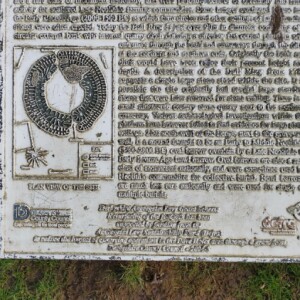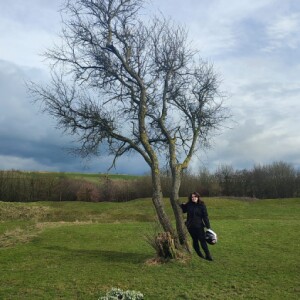Older than the Great Pyramid...
No, not Biscuit you 'nanas, the earthwork!
(Last Emergency Nightshift Blip for this week)
For many years when travelling through Dove Holes enroute to Buxton & beyond, I have passed an inoccuous sign pointing to the left stating 'Henge' and wondered what said Henge was exactly.
Last Sunday on our travels, eldest dahling who is studying Classics at Uni decreed that we should find out and so we did. There she is to the right of the image talking pictures with her phone.
The earthwork in question lies just behind their local Cricket Club and is a Bullring Henge dating back to Neolithic times i.e: old!
The information board (extra 1) was not very legible but reads as follows:
The Bull Ring is a Henge monument constructed in the late Neolithic (2800-2000BC). Henges are a rare class of monument nationally, and were probably centres of ceremony and ritual for scattered Late Neolithic farming communities. Some Henges continued in use into the Early Bronze Age (2000-1500BC) and which time circles and other settings of large standing stones were erected. Today the Bull Ring is just over 90m in diameter consisting of a circular external bank with internal quarry ditch defining a circular, flat central platform with entrances through the bank and causeways through the ditch at the Northern and Southern ends. Originally the bank and ditch would have been twice their current height and depth. A description of the Bull Ring from 1789 suggests a single large stone stood within the site. It is possible the site originally had several large standing stones that were later removed for stone walling. There is a small nineteenth century stone quarry next to the Northern causeway. Various archeological investigations within the platform have however failed to find evidence for large stone settings. 20m Southwest of the henge, next to the graveyard is a mound thought to be an Early to Middle Neolithic (3400-2800BC) oval barrow overlain with by a Late Neolithic to Early Bronze Age bowl barrow. Oval barrows are also a rare class of monument nationally, and were sometimes used by Neolithic Communities for collective burial. Bowl barrows are much less rare nationally and were used for single or multiple burial.
Extra 2 is eldest next to a tree that appears to have sprouted within the Henge and is listing somewhat. The site is quite high up and exposed so am wondering if the wind have influenced that! Am a little surprised it has been left to grow there given the carnage tree roots may do to the earthwork over time.



Comments
Sign in or get an account to comment.


